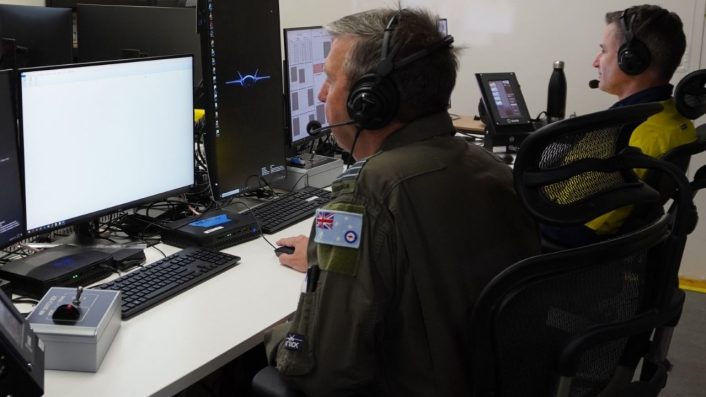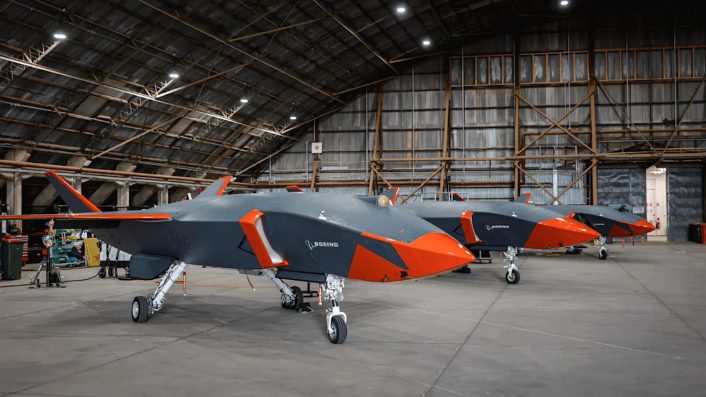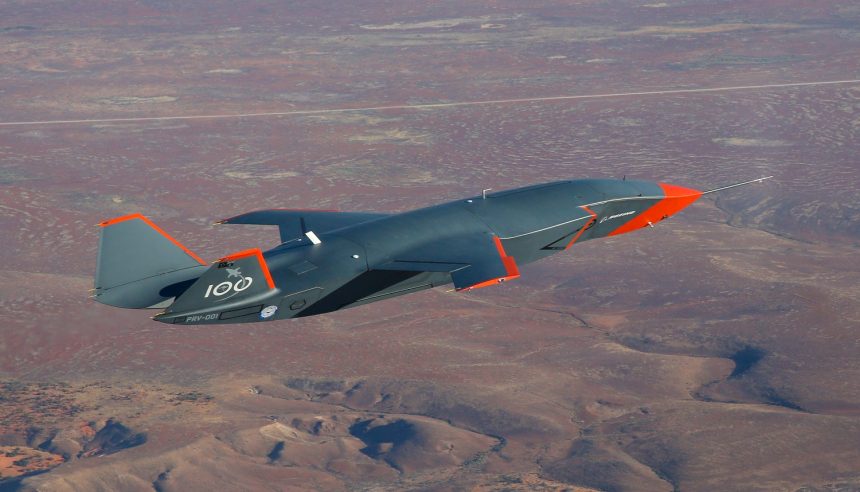The first RAAF pilot has completed the training to be certified as launch and recovery operator for the MQ-28, becoming the first non-Boeing pilot on the program.
Boeing’s MQ-28A Ghost Bat program achieved another milestone when the first RAAF (Royal Australian Air Force) pilot, Wing Commander Phil Parsons, flew the aircraft from its ground control station. Parsons, an experienced remote systems pilot for the past 10 years, concluded his training program at Boeing on Jun. 13, 2024, and became the first non-Boeing pilot on the program, said a statement from the defense major.
As a launch and recovery operator, Parsons would oversee the MQ-28A’s ground preparation, take-off and landing operations In fact, while it has autonomous capabilities, the MQ-28 is still overseen by a human operator. “MQ-28A is designed to team with piloted aircraft through an ‘operator-in-the-loop’ approach,” said Glen Ferguson, Boeing Defence Australia MQ-28 program director.

The presence of a human operator adds another layer of safety to the operations. In fact, Parsons’ training included observing and monitoring the aircraft as it executed commands to climb and descend, accelerate and decelerate, or navigate to a specific waypoint to achieve test points as part of the current advanced testing program.
“The MQ-28A, while similar in many aspects of operation to other remotely piloted systems, is embracing technological advancements in how a launch and recovery operator interacts with the aircraft,” Parsons said.
MQ-28A Ghost Bat
Designed by Boeing Defence Australia for the RAAF as a multirole system capable of operating together with crewed aircraft, the Ghost Bat was initially known as the Boeing Airpower Teaming System (ATS). The development commenced in 2013, with the prototype unveiled for the first time during the 2019 edition of the Australian Airshow and the maiden flight on Feb. 27, 2021 at the Woomera Range Complex in Southern Australia.
The multirole unmanned platform has a 1.5 cubic meter nose that can hold interchangeable payloads for ISR (Intelligence, Surveillance and Reconnaissance), aerial radar surveillance, EW/ELINT sensors and other attack munitions. The aircraft has been described as a next-generation Loyal Wingman, whose development involved 55 Australian companies and, as of Feb. 2024, had received $600 million in funding.

According to Boeing, the Ghost Bat employs “AI (Artificial Intelligence) to work as a smart team with existing military aircraft to complement and extend airborne missions.” At 38 feet long with side air intakes, two cranked-kite wings, canted V-tails, the MQ-28 can fly for nearly 3,200 km and “fly independently” with its AI.
The size of a small, light-weight class fighter, renditions from Boeing have shown the Ghost Bat flying with support and special mission aircraft like the E-7A Wedgetail AEW&C and the F-15EX. According to Ferguson, “during a typical mission, a launch and recovery operator like Wing Commander Parsons would oversee the aircraft as it takes flight.”
“It would then be handed off to a crewed aircraft, such as an E-7A, F-35A or F/A-18F, whose crew tasks it to perform, for example, an intelligence, surveillance and reconnaissance mission,” added Ferguson while explaining the concept of operations. The MUM-T (Manned Unmanned Teaming) might not necessarily have to be in close formation but even very far apart over dozens or even hundreds of kilometers, depending on mission requirements.
Our recent #LoyalWingman test flights with @AusAirForce took the uncrewed aircraft further and faster, with two aircraft completing testing at the Woomera Range Complex in South Australia.#AirpowerTeaming
Release: https://t.co/Q6RggQ0GuE pic.twitter.com/bX9LT3kG2X
— Boeing Defense (@BoeingDefense) November 4, 2021
The heavily stealth-oriented design has also been shown to have three different nose sections in computerized illustrations, with one having what appears to be a FLIR/IRST (Forward-Looking Infrared/Infrared Search and Track). Based on their appearance, the other two could possibly be meant for ISR and EW/ELINT roles, the latter involving locating, jamming or overwhelming adversary ground radars.
The MQ-28 could also serve in an escort role for high-value support assets like the E-7A AEW&C aircraft or KC-30 aerial refuelers. It is however not known if the unmanned aircraft is viewed as an attritable system used for enhancing manned platforms’ survivability. Following the mission’s completion, “the aircraft would be handed back to the launch and recovery operator to oversee landing, deceleration and complete stop of the vehicle,” Ferguson said.
Earlier this year, the Australian government has announced $259.5 million in funding to further develop key systems for the Boeing MQ-28A and build three new aircraft in the Block 2 configuration. The Block 2 will have an enhanced design and improved capabilities, with the funding supporting also additional critical sensors and mission payloads.
Eight Block 1 Ghost Bats have already been manufactured to date, while the Block 2 are expected to be ready by next year, when they will participate in a critical capability demonstration exercise. Australia’s minister for defense industry, Pat Conroy, said that one objective for the programme, following the demonstration phase in 2025, will be the ability to produce MQ-28As at 10% of the cost of an aircraft such as the F-35A.
Australia-specific platform
The MQ-28A’s induction in the ADF (Australian Defence Force) is also consistent with the country’s 2023 DSR (Defence Strategic Review) recommendations “to prioritise the MQ-28A program for collaborative development with the United States, meaning it can more easily share classified information with Australia’s closest military ally,” ABC (Australia Broadcasting Corporation) said.
The handover of piloting control to Australian defense personnel is a part of a larger effort to shift the “focus from testing the aircraft’s flying and handling qualities to capability advancement including progressing teaming behaviors, mission systems, sensors and payload testing.” This means the RAAF is currently developing tactics, training and procedures and fully understand the Ghost Bat’s capabilities under various scenarios before incorporating into larger operational plans.
The Pentagon confirmed in 2022 that it acquired at least one MQ-28 for research and development purposes on behalf of the U.S. Air Force. While the plans for its use have not been disclosed, Secretary of the Air Force Frank Kendall referred to the Ghost Bast as a “technology feeder” for the Collaborative Combat Aircraft (CCA) program.
Boeing was not among the companies selected for the first tranche of the CCA program, although Boeing intends to continue pitching its design for the Increment 2. However, it is being reported that Boeing officials noted that the company will not agree to a fixed-price contract.









